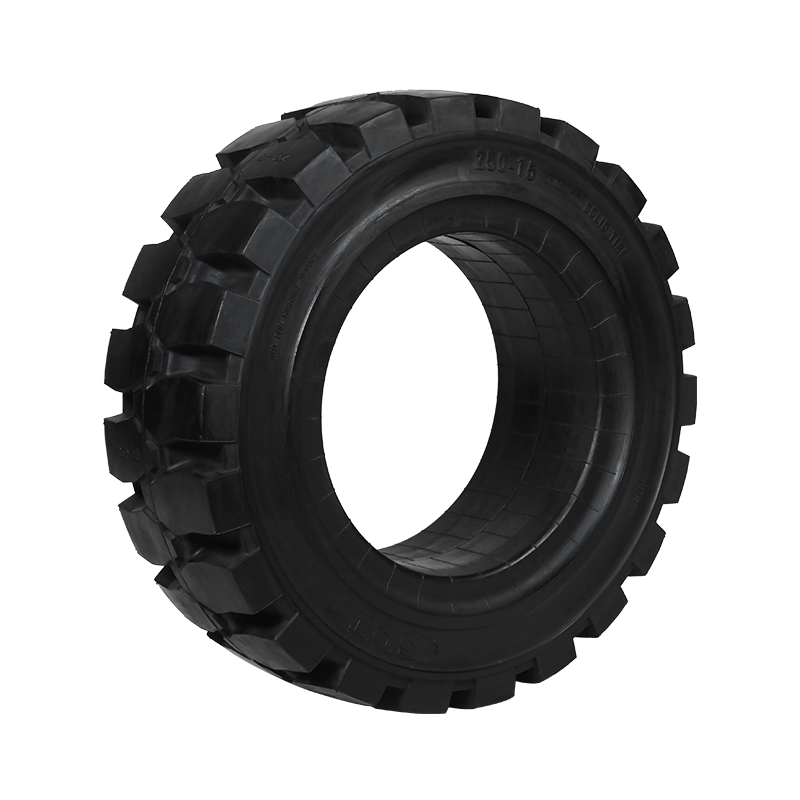How do Boom Lift Tires ensure their grip on various surface conditions such as wet, muddy or gravel surfaces?
To ensure that Boom Lift Tires have excellent grip in various ground conditions, such as wet, muddy or gravel, tire designers and manufacturers will take a variety of technical and material optimization measures.
Tire pattern is one of the key factors affecting grip. For aerial work platform tires, designers usually use the following pattern designs:
This design can effectively drain water and help the tire maintain good grip on slippery ground (such as muddy ground after rain or slippery concrete ground). Optimization of groove depth and width can help the tire better penetrate the surface water layer and contact the solid ground, thereby improving grip.
Multi-directional pattern design can provide all-round grip, especially on muddy or gravel ground. The multi-directional pattern of the tire can increase the contact area and prevent the tire from slipping on the ground.
The edge part of the tire may be designed to have more cutting function, which helps to better penetrate in soft ground or sand, thereby improving grip.
The rubber compound of the tire is one of the key factors that determine its performance in different ground conditions. Aerial work platform tires often use specially formulated high-friction rubber materials to enhance contact with the ground. In slippery or muddy conditions, increased friction can effectively reduce slippage.

On rough surfaces such as gravel, wear-resistant rubber can extend tire life while maintaining good grip. By adding wear-resistant ingredients, tires can withstand greater friction without being easily damaged.
The rubber formula can also be adjusted according to different operating temperatures. For example, in low temperature environments, the rubber still maintains good flexibility to avoid sliding on ice and snow roads.
Adjusting the tire pressure also has a great impact on grip. Too high air pressure will cause the center of the tire to contact the ground, thereby reducing grip; while too low air pressure may cause the edges and center areas of the tire to touch the ground evenly, thereby improving grip, especially on soft or uneven ground.
Some aerial work platform tires may use adjustable air pressure technology, which allows the tire to adjust the air pressure as needed in different operating environments to optimize grip and stability.
Some high-end models of tires are equipped with an air pressure monitoring system that monitors the tire pressure in real time to ensure that the tire is always in the best condition, thereby improving grip.
The sidewall and shoulder parts play an important role in the stability and grip of the tire, especially when working on uneven ground:
By thickening the sidewall or using tougher materials, the tire can provide stronger support on soft or rugged ground, prevent side slipping and enhance grip.
Wide shoulders can increase the tire's contact area and provide stronger traction on soft ground such as mud and gravel.
Different ground conditions may require different types of tire materials. In order to ensure the best grip and adaptability, many aerial work platform tires use a variety of composite materials to improve their performance on various grounds:
The wire layer can improve the durability and puncture resistance of the tire, avoid damage to the tire on gravel or rough ground, and improve ground traction.
Different proportions of rubber can improve the adaptability of the tire in wet, slippery, gravel and other conditions, thereby optimizing grip.
The inflation method and profile design of the tire can also affect its performance under special ground conditions:
Low-pressure tires are generally more suitable for soft and uneven ground than high-pressure tires. Low-pressure tires can provide a larger contact area, thereby enhancing grip, especially on sandy or muddy ground.
The design that is wider than standard tires can effectively disperse the pressure of the tire on the ground, reduce indentation and sliding, improve traction and stability, and is suitable for use on uneven gravel or slippery ground.
By comprehensively considering multiple factors such as tire pattern design, rubber formula, pressure adjustment, material selection, etc., aerial work platform tires can provide excellent grip performance under different ground conditions. The optimization of these designs and technologies not only improves the working efficiency of the tires, but also increases the safety of operations and reduces the risks of slipping and rollover.
CONTACT US
-

Email: SMT001@saimeite-tyre.com
-

Phone: +86-18451337018No. 1, Renmin South Road, Yandu District, Yancheng City, Jiangsu Province, China

 English
English 한국어
한국어 Français
Français Español
Español











